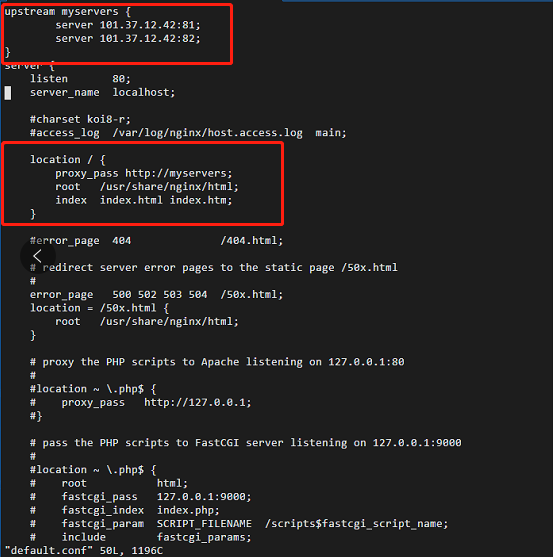Docker 安装 Nginx 负载均衡配置
Docker 安装
# 1)安装依赖包 yum install -y yum-utils device-mapper-persistent-data lvm2 # 2)添加Docker软件包源(否则doker安装的不是新版本) yum-config-manager \ --add-repo \ https://download.docker.com/linux/centos/docker-ce.repo # 3)安装Docker CE yum install -y docker-ce # 4)启动Docker服务并设置开机启动 systemctl start docker systemctl enable docker # 5)测试docker是否安装成功(hello-world是官方提供的一个测试镜像) docker run hello-world # 6)查看docker基本信息 docker info docker version # 7)下载Nginx镜像 docker run -itd nginx
docker简单使用(创建一个ngixn容器)
# 1、创建一个nginx容器 docker run -it nginx # 2、查看docker运行的容器(可以获取到这个容器的id) docker ps # 3、访问这个容器 # 进入这个nginx容器(进入的文件系统和宿主机是完全隔离的,有自己独立的文件系统) docker exec -it 73877e65c07d bash # 4、查看当前容器的 IP docker inspect 73877e65c07d # 73877e65c07d是通过docekr ps查看到的容器ID curl 172.17.0.2 # 测试这个nginx容器是否可以访问
Nginx负载均衡配置
# 使用docker搭建第一台nginx服务 [root@linux-node4 ~]# docker container run -d --name web01 -p 81:80 nginx 测试访问:http://192.168.56.14:81/ # 可以在浏览器输入自己的地址,访问到Nginx页面 root@c58a7f1fb89d:/# docker exec -it web01 bash root@c58a7f1fb89d:/# echo web01 > /usr/share/nginx/html/index.html
# 使用docker搭建第二台nginx服务 [root@linux-node4 ~]# docker container run -d --name web02 -p 82:80 nginx 测试访问:http://192.168.56.14:82/ # 可以在浏览器输入自己的地址,访问到Nginx页面
root@a3440d30f27c:/# docker exec -it web02 bash root@a3440d30f27c:/# echo web02 > /usr/share/nginx/html/index.html
默认轮训(在真实主机中安装nginx并配置负载均衡)
[root@izbp19kniw9k2ljqdjmld5z ~]# cd /etc/nginx/conf.d [root@izbp19kniw9k2ljqdjmld5z conf.d]# vim default.conf

# upstream是自己写的,一定要放在server外面,切记端口号是自己的 upstream myservers { server 192.168.56.14:81; server 192.168.56.14:82; } # server其实默认已经有一个,只需要修改location中配置,指定转发代理即可 server { location / { proxy_pass http://myservers; } } # 配置好以后保存执行下面这俩条命令即可: # 重启:systemctl restart nginx # 开启 systemctl start nginx # 简单的配置就OK了!

Nginx 配置文件注释
#运行用户 user nobody; #启动进程,通常设置成和cpu的数量相等 worker_processes 1; #全局错误日志及PID文件 #error_log logs/error.log; #error_log logs/error.log notice; #error_log logs/error.log info; #pid logs/nginx.pid; #工作模式及连接数上限 events { #epoll是多路复用IO(I/O Multiplexing)中的一种方式, #仅用于linux2.6以上内核,可以大大提高nginx的性能 use epoll; #单个后台worker process进程的最大并发链接数 worker_connections 1024; # 并发总数是 worker_processes 和 worker_connections 的乘积 # 即 max_clients = worker_processes * worker_connections # 在设置了反向代理的情况下,max_clients = worker_processes * worker_connections / 4 为什么 # 为什么上面反向代理要除以4,应该说是一个经验值 # 根据以上条件,正常情况下的Nginx Server可以应付的最大连接数为:4 * 8000 = 32000 # worker_connections 值的设置跟物理内存大小有关 # 因为并发受IO约束,max_clients的值须小于系统可以打开的最大文件数 # 而系统可以打开的最大文件数和内存大小成正比,一般1GB内存的机器上可以打开的文件数大约是10万左右 # 我们来看看360M内存的VPS可以打开的文件句柄数是多少: # $ cat /proc/sys/fs/file-max # 输出 34336 # 32000 < 34336,即并发连接总数小于系统可以打开的文件句柄总数,这样就在操作系统可以承受的范围之内 # 所以,worker_connections 的值需根据 worker_processes 进程数目和系统可以打开的最大文件总数进行适当地进行设置 # 使得并发总数小于操作系统可以打开的最大文件数目 # 其实质也就是根据主机的物理CPU和内存进行配置 # 当然,理论上的并发总数可能会和实际有所偏差,因为主机还有其他的工作进程需要消耗系统资源。 # ulimit -SHn 65535 } http { #设定mime类型,类型由mime.type文件定义 include mime.types; default_type application/octet-stream; #设定日志格式 log_format main '$remote_addr - $remote_user [$time_local] "$request" ' '$status $body_bytes_sent "$http_referer" ' '"$http_user_agent" "$http_x_forwarded_for"'; access_log logs/access.log main; #sendfile 指令指定 nginx 是否调用 sendfile 函数(zero copy 方式)来输出文件, #对于普通应用,必须设为 on, #如果用来进行下载等应用磁盘IO重负载应用,可设置为 off, #以平衡磁盘与网络I/O处理速度,降低系统的uptime. sendfile on; #tcp_nopush on; #连接超时时间 #keepalive_timeout 0; keepalive_timeout 65; tcp_nodelay on; #开启gzip压缩 gzip on; gzip_disable "MSIE [1-6]."; #设定请求缓冲 client_header_buffer_size 128k; large_client_header_buffers 4 128k; #设定虚拟主机配置 server { #侦听80端口 listen 80; #定义使用 www.nginx.cn访问 server_name www.nginx.cn; #定义服务器的默认网站根目录位置 root html; #设定本虚拟主机的访问日志 access_log logs/nginx.access.log main; #默认请求 location / { #定义首页索引文件的名称 index index.php index.html index.htm; } # 定义错误提示页面 error_page 500 502 503 504 /50x.html; location = /50x.html { } #静态文件,nginx自己处理 location ~ ^/(images|javascript|js|css|flash|media|static)/ { #过期30天,静态文件不怎么更新,过期可以设大一点, #如果频繁更新,则可以设置得小一点。 expires 30d; } #PHP 脚本请求全部转发到 FastCGI处理. 使用FastCGI默认配置. location ~ .php$ { fastcgi_pass 127.0.0.1:9000; fastcgi_index index.php; fastcgi_param SCRIPT_FILENAME $document_root$fastcgi_script_name; include fastcgi_params; } #禁止访问 .htxxx 文件 location ~ /.ht { deny all; } } }
Nginx配置举例
user work; worker_processes 8; worker_rlimit_nofile 65535; error_log logs/error.log warn; #error_log logs/error.log notice; #error_log logs/error.log info; pid logs/nginx.pid; events { use epoll; worker_connections 65535; } # load modules compiled as Dynamic Shared Object (DSO) # #dso { # load ngx_http_fastcgi_module.so; # load ngx_http_rewrite_module.so; #} http { include mime.types; default_type application/octet-stream; server_names_hash_bucket_size 128; sendfile on; tcp_nopush on; tcp_nodelay on; fastcgi_connect_timeout 5; fastcgi_send_timeout 10; fastcgi_read_timeout 10; fastcgi_buffer_size 64k; fastcgi_buffers 4 64k; fastcgi_busy_buffers_size 128k; fastcgi_temp_file_write_size 128k; #keepalive_timeout 0; keepalive_timeout 60; keepalive_requests 1024; client_header_buffer_size 4k; large_client_header_buffers 4 32k; client_max_body_size 10m; client_body_buffer_size 512k; client_body_timeout 600; client_header_timeout 600; send_timeout 600; proxy_connect_timeout 1000ms; proxy_send_timeout 2000000ms; proxy_read_timeout 2000000ms; proxy_buffers 64 8k; proxy_busy_buffers_size 128k; proxy_temp_file_write_size 64k; proxy_redirect off; #proxy_next_upstream off ; gzip on; gzip_min_length 1k; gzip_buffers 4 16k; gzip_http_version 1.0; gzip_comp_level 2; gzip_types text/plain application/x-javascript text/css application/xml; gzip_vary on; add_header X-Frame-Options "ALLOW-FROM http://cloud.njsig.cn"; proxy_set_header X-Real-IP $remote_addr; proxy_set_header X-Real-Port $remote_port; proxy_set_header Host $host; proxy_set_header X-Forwarded-For $proxy_add_x_forwarded_for; log_format main '$remote_addr - $remote_user [$time_local] "$request" ' '$status $body_bytes_sent "$http_referer" "$http_cookie" "$http_user_agent" ' '$request_time $remote_addr $server_addr $upstream_addr $host ' '"$http_x_forwarded_for" $upstream_response_time'; set_real_ip_from 10.0.0.0/8; real_ip_header X-Real-IP; #example # server { # listen 8000; # server_name www; # access_log logs/access.log main; # location / { # proxy_pass http://127.0.0.1:8001; # } # # # } include vhosts/*.conf; }
nginx/conf/vhosts/opwf.conf django项目简单配置
server { listen 80; server_name aaa.test.com bbb.test.com; access_log /home/work/nginx/logs/opwf_access.log main; location / { proxy_pass http://127.0.0.1:8001; } }
nginx/conf/vhosts/opwf.conf django项目简单配置
server { listen 80; server_name ccc.test.com; access_log /home/work/nginx/logs/nj1_access.log main; root /home/work/project/frontopwf/dist; location / { try_files $uri $uri/ @router; } location @router { rewrite ^.*$ /index.html last; } }
你其实不是怕高,你只是怕坠落。


